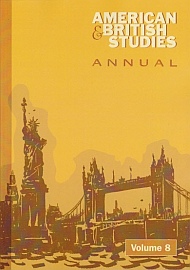Applying Strategies of the Snobographer: Charles W. Chesnutt’s Use of Thackeray in Two “Blue Vein Society” Stories
Keywords:
Chesnutt; Thackeray; intertextual studies; snobs; signifying; Vanity Fair; American short storyAbstract
No fiction writer wrote substantively about intra-racial snobs among African Americans before Charles W. Chesnutt. In his “Blue Vein Society” stories, this snobbery is acutely expressed through moneyed cultural edification in “The Wife of His Youth” as well as in blatantly racial terms in “A Matter of Principle.” Long an admirer of Vanity Fair, Charles W. Chesnutt shared with the early Thackeray a keen interest in satirically exposing the hypocrisy of the haughty “higher” society. In this contribution, I attempt to demonstrate the impact of Thackeray’s works on the strategies of Chesnutt’s depictions of the African American snob.
References
Andrews, William. The Literary Career of Charles W. Chesnutt. Baton Rouge: Louisiana State University Press, 1980.
Berman, Russell. “Du Bois and Wagner: Race, Nation, and Culture between the United States and Germany.” German Quarterly 70.2 (1997): 123-135.
Bernard, Fred V. “The Question of Race in Moby Dick.” Massachusetts Review 43.3 (2002): 384-404.
Chesnutt, Charles W. An Exemplary Citizen. Letters of Charles W. Chesnutt 1906-1932. Stanford: Stanford University Press, 2002.
Chesnutt, Charles W. Conjure Tales and Stories of the Color Line. New York: Penguin Classics, 2000.
Chesnutt, Charles W. Essays and Speeches. Stanford: Stanford University Press, 1999.
Chesnutt, Charles W. The Journals of Charles W. Chesnutt. Edited by Richard Broadhead. Durham, Duke University Press, 1993.
Chesnutt, Charles W. To Be an Author: Letters of Charles W. Chesnutt 1889-1905. Edited by McElrath and Leitz. Princeton: Princeton University Press, 1997.
Derrida, Jacques. Spectres of Marx. London: Routledge, 2004.
Du Bois, W.E.B. The Souls of Black Folk. New York: Penguin, 1989.
Duncan, Charles. The Absent Man: The Narrative Craft of Charles W. Chesnutt. Athens, Ohio University Press, 1998.
Edwards, Paul, and James Walvin. Black Personalities in the Era of the Slave Trade. Baton Rouge: Louisiana State University Press, 1983.
Fishkin, Shelley Fisher. Was Huck Black? Mark Twain and African-American Voices. New York: Oxford University Press, 1983.
Gates, Henry Louis. The Signifying Monkey. New York: Oxford University Press, 1988.
Gilman, Sander L. “Black Sexuality and Modern Consciousness.” In Blacks and German Culture. Madison: University of Wisconsin Press, 1985.
Jones, LeRoi. Home: Social Essays. New York: William Morrow, 1966.
Keller, Frances Richardson. An American Crusade: The Life of Charles Waddell Chesnutt. Provo: Brigham Young University Press, 1978.
Koy, Christopher. “‘Stan’ in wid de Angry-Saxon Race:’ Charles W. Chesnutt and the Railroad Motif.” In America in Motion. Edited by Marcel Arbeit, Roman Trušník, 65-79. Olomouc: Palacký University Press, 2010.
Ramsey, William M. “Family Matters in the Fiction of Charles W. Chesnutt.” In Southern Literary Journal 33.2 (Spring 2001): 30-43.
Redding, J. Saunders. To Make a Poet Black. Ithaca: Cornell University Press, 1988.
Robbins, Hollis. “Blackening Bleak House: Hannah Crafts’ The Bondwoman’s Narrative.” In In Search of Hannah Crafts: Critical Essays on The Bondwoman’s Narrative. 71-86. New York: Basic Civitas, 2004.


